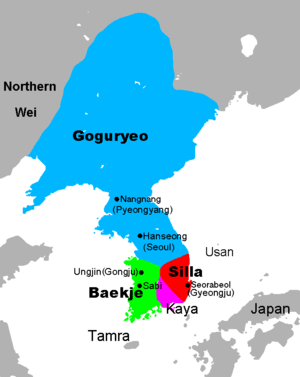Baekje language
| Buyeo-Baekje | |
|---|---|
| Puyo-Paekche | |
| Native to | Paekche |
| Region | Korea |
| Era | 5th–7th centuries[1] |
| Language codes | |
| ISO 639-3 |
xpp |
Linguist list |
xpp |
| Glottolog | None |
| Old Baekje | |
|---|---|
| Han-Paekche | |
| Native to | Paekche |
| Region | Korea |
| Era | 5th–7th centurieslinglist2 |
|
Unclassified (Japonic?) | |
| Language codes | |
| ISO 639-3 |
pkc |
pkc | |
| Glottolog |
paek1234[2] |
|
The Three Kingdoms of Korea, with Baekje in green. | |
The language of the ancient kingdom of Baekje (18 BCE – 660 CE), one of the Three Kingdoms of Korea, is sparsely attested; indeed, it is not clear that what material exists is from the same language.
Since Baekje was established by immigrants from Goguryeo (the Buyeo-Baekje / Puyo-Paekche), it is presumed that they spoke the Goguryeo language, and several attested words support this idea; however, even if that is true, it is not known which language the indigenous Samhan people (Han-Baekje) spoke, or if the attested material may be a mix of Goguryeo and Samhan. The Gaya confederacy, however, was founded by one of the Samhan tribes, so it's possible that the old Baekje language was related to Gaya; based on toponymic evidence, it may be then that Buyeo-Baekje was related to Korean, and Han-Baekje, despite the name, to Japanese.
See also
References
- ↑ Buyeo-Baekje at MultiTree on the Linguist List
- ↑ Hammarström, Harald; Forkel, Robert; Haspelmath, Martin; Bank, Sebastian, eds. (2016). "Paekche". Glottolog 2.7. Jena: Max Planck Institute for the Science of Human History.
